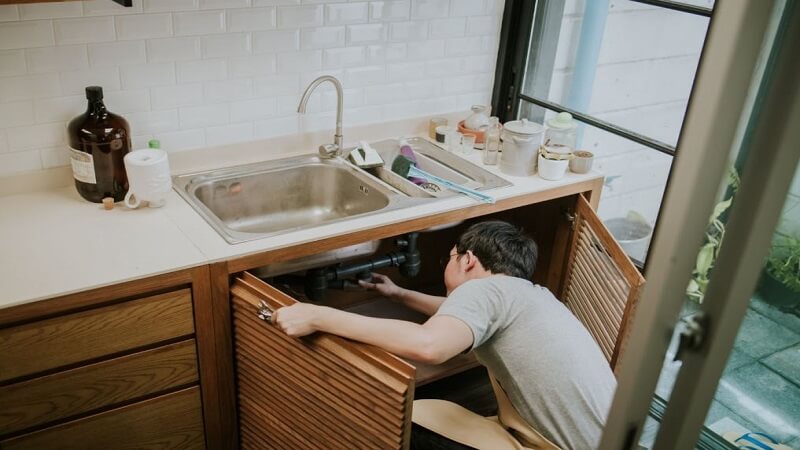Plumbing a kitchen sink involves connecting the sink, faucet, and drain system to secure proper water flow and drainage. The process includes assembling the sink components, attaching the faucet, connecting the water supply lines, and sealing the drain pipes. While DIY plumbing is possible, complex installations may require professional expertise for reliable results.
Table of Contents
- Tools and Materials You’ll Need for the Job
- Step-by-Step Guide to Plumbing a Kitchen Sink
- Final Thoughts: Achieving a Leak-Free Kitchen Sink
Whether you’re remodeling your kitchen or installing a brand-new sink, understanding how to plumb it correctly is essential for avoiding leaks and securing smooth functionality. Plumbing a kitchen sink might seem intimidating at first, but with the right tools and approach, it’s a manageable DIY project.
That said, not every plumbing task is straightforward, especially in older homes or unique configurations. For instance, if you encounter corroded pipes or mismatched fittings, turning to reliable tip top plumbing solutions can save time and prevent costly mistakes. In this article, we’ll walk you through the steps to plumb a kitchen sink, highlight common pitfalls, and discuss when professional assistance might be necessary.
Tools and Materials You’ll Need for the Job
Before starting, gather the necessary tools and materials to secure a smooth installation process. Having everything on hand will help you work efficiently and avoid interruptions during the installation. Here’s a detailed list of essentials:
- Adjustable Wrench: A versatile tool for tightening nuts and bolts, especially useful for securing water supply lines and drain fittings.
- Pipe Wrench: Designed for gripping and turning pipes, this tool is ideal for handling larger pipes and fittings under the sink.
- Plumber’s Putty or Silicone Sealant: These materials create watertight seals around drains, faucets, and other components. Plumber’s putty is often used for metal drains, while silicone sealant works well for plastic or porcelain surfaces.
- Teflon Tape (Plumber’s Tape): This thin, white tape is wrapped around threaded connections to prevent leaks. It’s particularly important for sealing threaded joints on water supply lines and faucet connections.
- Basin Wrench: A specialized wrench with a long handle and pivoting head, perfect for reaching tight spaces under the sink where standard wrenches can’t fit.
- PVC Pipes and Fittings: These components are used to assemble the drain system, including the P-trap, tailpiece, and extension pipes. PVC is lightweight, durable, and easy to cut and assemble.
- Flexible Water Supply Lines: These hoses connect the faucet to the shut-off valves under the sink. They’re typically made of braided stainless steel for durability and flexibility.
- Bucket or Towels: To catch any spills or drips during the process. Keeping a dry workspace is crucial for safety and preventing water damage.
- Drain Auger or Plunger (Optional): Useful for clearing clogs in existing drain lines before installation.
Step-by-Step Guide to Plumbing a Kitchen Sink
Assembling the Sink Components
The first step in plumbing a kitchen sink is assembling the sink components, starting with the basket strainer and drain assembly. Begin by applying plumber’s putty or silicone sealant around the base of the strainer before inserting it into the sinkhole. This creates a watertight seal that prevents leaks. Once the strainer is in place, tighten the locknut securely underneath the sink using a wrench. Be careful not to overtighten, as this can crack plastic components.
If your sink includes additional features like a garbage disposal, follow the manufacturer’s instructions to install it. Make sure all connections are snug and properly aligned before moving on to the next step. Double-check the alignment of the disposal unit to avoid future drainage issues.
Installing the Faucet and Accessories
Once the sink components are assembled, the next step is installing the faucet and any accompanying accessories, such as a sprayer or soap dispenser. Begin by reading the manufacturer’s instructions carefully, as different faucets may have unique installation requirements.
Start by applying Teflon tape (plumber’s tape) to the threaded connections on the faucet’s water inlets. Wrap the tape clockwise around the threads, securing an even layer to create a watertight seal. This small step is critical to preventing leaks at the faucet connections.
Next, position the faucet onto the designated holes in the sink deck. From underneath the sink, attach the mounting nuts and secure them tightly using a basin wrench. Be cautious not to overtighten, as this can damage the faucet or the sink surface. If your faucet includes additional features like a pull-down sprayer or touchless operation, connect the electrical components (if applicable) according to the manufacturer’s guidelines.
If your setup includes accessories like a side sprayer or soap dispenser, install these components at this stage. Follow the same process of applying Teflon tape and securing the connections tightly but carefully. Double-check all connections to make sure they’re secure before moving on to the next step.
Connecting the Water Supply Lines
With the faucet installed, it’s time to connect the water supply lines. Begin by attaching the flexible water supply hoses to the faucet’s hot and cold water inlets. Use an adjustable wrench to tighten the connections, but avoid over-tightening, as this can damage the fittings or cause leaks.
Once the faucet connections are secure, attach the other end of the water supply lines to the shut-off valves under the sink. These valves control the flow of water to the faucet, so make sure they’re turned off before making the connections. After securing the lines, inspect each connection for visible gaps or loose fittings.
Before proceeding, slowly turn the water supply back on and check for leaks at each connection. Run both the hot and cold water through the faucet to confirm proper water flow. If you notice any drips, tighten the connections slightly and retest. Addressing leaks at this stage will prevent more significant issues later on.
Sealing and Testing the Drain System
The final step in plumbing a kitchen sink is assembling and sealing the drain system. Start by connecting the P-trap to the sink’s drainpipe and the wall’s drain outlet. The P-trap is a U-shaped pipe that prevents sewer gases from entering your home while allowing water to flow freely. Make sure all joints are snug and sealed properly using plumber’s putty or silicone sealant.
Tighten the slip nuts by hand first, then use a wrench to secure them further. Once assembled, double-check the alignment of the P-trap to secure proper drainage. A misaligned P-trap can cause poor water flow or pooling under the sink.
With the drain system assembled, test it by running water through the faucet. Check for leaks at all connections and listen for unusual noises, such as gurgling or bubbling, which may indicate air trapped in the pipes. If the drain system is noisy or slow, consider adjusting the angle of the pipes to improve water flow.
Final Thoughts: Achieving a Leak-Free Kitchen Sink
Plumbing a kitchen sink is a rewarding project that can enhance your home’s functionality and aesthetics. By following the steps outlined above—starting with assembling the sink components, installing the faucet, connecting the water supply lines, and sealing the drain system—you can achieve a successful installation. Each step plays a crucial role in securing proper water flow, efficient drainage, and leak-free performance.

